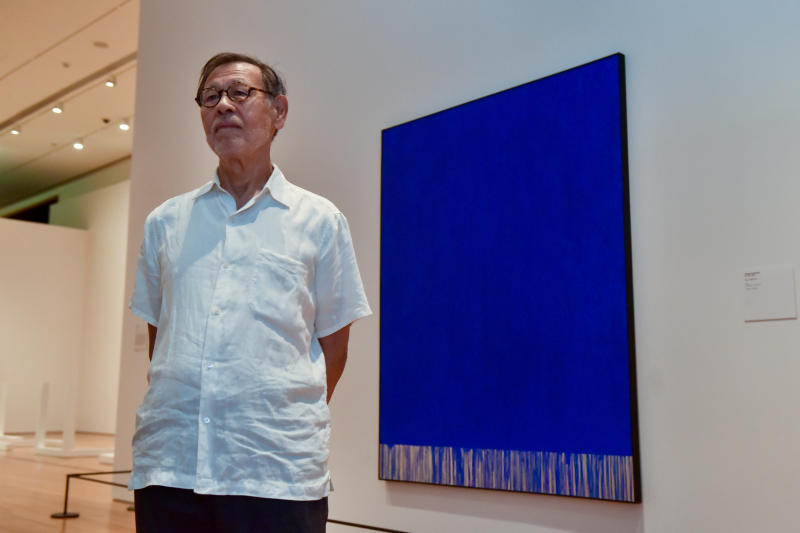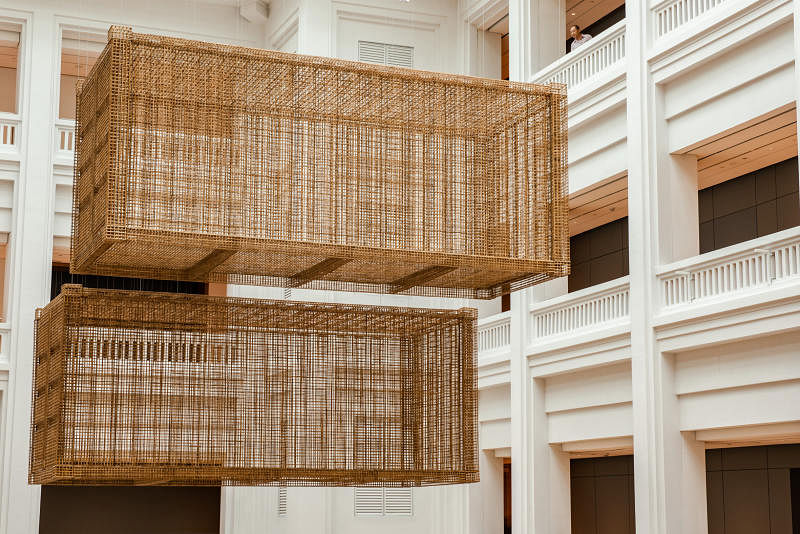Asian roots of Minimalism explored in exhibition at National Gallery and ArtScience Museum
Sign up now: Get ST's newsletters delivered to your inbox

Artist Tadaaki Kuwayama, who is 86 this year, poses with his work, Blue TK684-60.
ST PHOTO: JASMINE CHOONG
Follow topic:
SINGAPORE - Think "minimalism" and one thinks of geometric objects, neutral colours and a life lived with few material possessions.
But a little-known fact about the 20th-century art movement, which radically changed how art was created and presented, is that it has roots in Asia.
A mega-exhibition at the National Gallery Singapore and the ArtScience Museum surveys the Asian roots of Minimalism, as well as the art movement's legacy and impact on South-east Asia.
Minimalism: Space. Light. Object. runs until April 14 next year and features more than 150 works of art from the 1960s to the present day.
Minimalist works became popular in New York in the 1960s, but many pioneering artists were influenced by Asian philosophies such as Zen Buddhism and the ideas of "endlessness" and "nothingness" found in Hindu scriptures.
Unlike preceding art movements, Minimalists did not emphasise the artist's decision-making and personal expression.
They aimed for a direct encounter between viewer and artwork.
Japanese artist Tadaaki Kuwayama, now 86, introduced two of his early works at the exhibition opening last week at the National Gallery, including Blue TK684-60, a long, deep-blue surface which leaves traces of paint at the bottom to show how the single-colour field was achieved.
The name comes from his initials, the size of the work and the year of its making, 1960.
It was painted in New York, when Kuwayama was in his 20s and rebelling against traditional Japanese painting styles or nihonga - think cherry blossoms on scrolls.
"I didn't think I was part of 'the Minimalism group'," the artist says in Japanese and English. "I was just making pure art."
Besides monochrome works, Minimalist artists experimented with geometric or repetitive shapes and with light.
Such works include the late Singaporean-British artist Kim Lim's 1973 piece Intervals I plus II, which allows the viewers to see patterns in its ladder-like structure; and Danish-Icelandic artist Olafur Eliasson's Room for one colour (1997) where the space is illuminated by mono-frequency lamps that suppress all colours except yellow and black.
Dr Eugene Tan, director of National Gallery Singapore, says the Minimalism exhibition "will further examine the connections and the legacies that this important movement has had on contemporary artists today".
"This is in keeping with the gallery's perspective of modern art as a global phenomenon that results from complex and interconnected developments happening all around the world," he adds.
One example is American artist Donald Judd's 1974 installation, Untitled (Six Boxes), namely six brass boxes placed on the floor and not on plinths, as would be usual for sculptures.
A contemporary response to Judd's work is Cargo by Cambodian-American artist Sopheap Pich.

The work features two boxes of bamboo, rattan and metal that took almost a year to create.
Long interested in shipping containers as objects that spread goods and thus lifestyles across the seas, Pich began work on Cargo only after visiting the Judd Foundation in Marfa, Texas.
"That was the push, the seismic moment, when I decided: 'just make the work'," says Pich, 47.
-
BOOK IT/MINIMALISM: SPACE. LIGHT. OBJECT.
WHERE: National Gallery Singapore, 1 St Andrew's Road and ArtScience Museum, 6 Bayfront Avenue
WHEN: Until April 14, 2019
ADMISSION: For Singapore residents: $15 (adult single entry to exhibition at National Gallery Singapore); $16 (adult single entry to ArtScience Museum); two-venue tickets start at $20 and include entry to other exhibitions at the venue where the ticket is purchased. Ticket prices for tourists start at $19 (adult single entry to one exhibition at either venue). Concessionary rates available.
INFO: minimalism.sg
Over at the ArtScience Museum, the exhibition is curated around the concept of the "enso" or circle drawn in a single brush-stroke as a meditative exercise by Zen Buddhists.
The museum hosts Lebanon-born Mona Hatoum's + and - (1994 to 2004), a sculpture inspired by Japanese Zen gardens. Circular layers of aluminium sand are created and destroyed by the sweeping action of a motor-driven scraper.
The museum also hosts Ring Of Stones (1982), a circle of stones 10m in diameter, tracing a walk taken by English land artist and sculptor Richard Long. Land art was a movement of the 1960s and 1970s in which artists, critical of the gallery-based industry, created work that could not be shown in such spaces.
"Sound and silence" also play a major role in the exhibition, says Ms Honor Harger, executive director of ArtScience Museum. The museum hosts a soundroom playing the works of 40 Minimalist composers, including influential Americans Steve Reich and Terry Riley, plus their precursor John Cage, who emphasised silence as an essential part of composition.
Near the sound room is a new work by Singaporean artist Jeremy Sharma, a roughly 34-minute audio installation in which male and female voices describe colour. In his "non-visual" approach to colour, Sharma, 41, is carrying out Minimalism's tradition of distilling art to its essentials. "Minimalism is just showing less but telling more," he says.
Similar playfulness is displayed at the National Gallery's ground-floor cafe Gallery & Co. For this exhibition, it has been transformed into British artist Martin Creed's Work No. 1343, the first Asian edition of his well-known restaurant project in which no single item is the same, from utensils to crockery to furniture.
More than 1,000 items, including furniture, plates, cups, spoons and forks, were replaced by unique items over six hours on the night of Nov 12. These items were lent or given by 50 donors, including artists and second-hand shops.
The work plays with Minimalist ideas about repetition by having multiple unique items and also draws from the movement's focus on the viewer experience.
"The artist is known for these very ironic, playful gestures," says gallery curator Silke Schmickl, who liaised with Creed to set up the work here.
"In keeping with ideas of Minimalism, he looks at how art transforms everyday spaces into new experiences, immersive experiences where the viewer completes the artwork."

